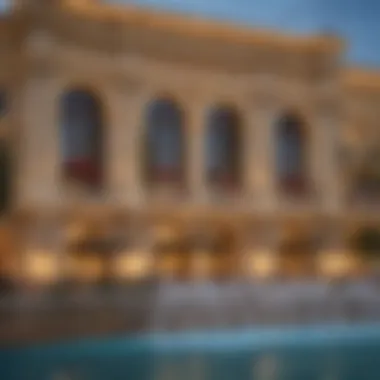Ownership and Role of MGM Resorts at the Bellagio


Intro
The Bellagio stands proud on the Las Vegas Strip, a shimmering symbol of luxury, glamour, and, perhaps, a bit of mystique. Its fountains dance rhythmically while guests stroll through its exquisite interiors, offering a glimpse into the high-stakes world of gaming and lavish entertainment. But beyond the glitz and glamour lies a complex ownership structure that has evolved over time, significantly shaped by MGM Resorts International. This article seeks to untangle the intricate web of ownership, management strategies, and their wider implications for guests, employees, and the local economy.
From its inception to its current position within MGM's portfolio, the journey of the Bellagio is not merely a tale of brick and mortar, but rather a narrative entwined with corporate strategy and market dynamics.
Understanding the Bellagio's ownership involves peering into MGM's strategic maneuvers that propelled it to the forefront of the hospitality industry. Amidst conversations around ownership changes and the repercussions of these shifts, one must contemplate how this affects the experience of visitors and the livelihoods of those who call Las Vegas home.
In the following sections, we will delve into the history, strategies, and implications that have defined the ownership saga of the Bellagio.
Background of the Bellagio
The Bellagio represents more than just a luxury resort and casino; it embodies the convergence of art, culture, and opulence that has become synonymous with the Las Vegas Strip. Understanding the foundation of the Bellagio is crucial in comprehending its role within MGM Resorts International’s broader strategy. This section examines the inception of the Bellagio, its distinctive design and architectural significance, as well as its profound cultural impact that remains palpable today. These elements collectively illustrate how the resort not only attracts high-stakes gamblers and luxury seekers but also influences the Las Vegas experience itself.
Inception of the Bellagio
The Bellagio first opened its doors in 1998, rising from the ashes of the Dunes Hotel and Casino which previously occupied the site. Its inception was the brainchild of Steve Wynn, an influential figure in Las Vegas's transformation from a simple desert town to a sprawling entertainment hub. With an investment reported to be around 1.6 billion dollars, Wynn envisioned a property that would redefine luxury. This attention to detail would set the tone for what the Bellagio would become.
The construction of the Bellagio was not merely about building a casino; it was about creating an experience. When guests first step foot on the property, they are greeted by the breathtaking Fountains of Bellagio, a choreographed water show set against the stunning backdrop of the hotel. The intricate design and lavish aesthetics were carefully curated to convey a sense of elegance and sophistication.
Design and Architectural Significance
The architectural style of the Bellagio draws heavy inspiration from the Italian village of Bellagio on Lake Como. The use of classically inspired elements, such as fountains, tiled roofs, and pastel colors, enhances its luxurious appeal. The hotel features an impressive 3,950 guest rooms and suites, rivaled by few in terms of both size and aesthetics.
The lobby features a stunning glass ceiling adorned with thousands of hand-blown glass flowers, created by artist Dale Chihuly. This centerpiece not only serves as a visual feast but also reinforces the Bellagio’s commitment to art and beauty, enhancing its status as an architectural gem. In addition, the hotel's gardens, known for their stunning seasonal displays, offer guests an immersive experience that transcends traditional casino atmospheres.
The Bellagio is not just a place to gamble; it is an environment that celebrates art, nature, and luxury, positioning itself as a cultural landmark.
Cultural Impact
Beyond its physical allure, the Bellagio has made its mark as a cultural icon within the broader tapestry of Las Vegas. It has been featured in numerous films and television shows, symbolizing the opulence and allure of high-stakes gambling. Movies like "Ocean's Eleven" and "The Hangover" have showcased the Bellagio's splendor, weaving it into the fabric of modern pop culture.
Furthermore, the resort hosts various art exhibits and performances that elevate the guest experience beyond mere gaming. The Bellagio Gallery of Fine Art is a notable example, showcasing exhibitions from renowned artists and contributing to the art scene of Las Vegas. This focus on art helps to differentiate the Bellagio from other properties, making it a cultural destination rather than just another casino.
In summary, the background of the Bellagio is rich with significance. Its inception was born from visionary ideals, its design resounds with elegance, and its cultural impact resonates far beyond its gaming floors. Understanding these aspects provides a solid foundation for analyzing the ownership and operational strategies by MGM Resorts International, establishing a connection between heritage and corporate future.
MGM Resorts International Overview
Understanding MGM Resorts International is key to grasping the intricacies of the Bellagio's ownership. This major player in the hospitality and gaming industry has played a pivotal role in shaping the landscape of entertainment and luxury accommodations in Las Vegas. The brand has successfully combined large-scale gaming, dining, and unique entertainment options, making it a household name among tourists and locals alike.
The importance of MGM Resorts extends beyond mere ownership; it’s about the synergy created between traditional casino gaming and high-end customer experience.


History and Formation
MGM Resorts International can trace its roots back to 1989, when it was initially established as MGM Grand Inc. This came on the heels of the MGM Grand Hotel and Casino opening in Las Vegas in 1993. Over time, the company underwent multiple transformations, including mergers and name changes, to eventually become the mighty MGM Resorts International we know today.
One of the notable milestones in its development was the merger with Mirage Resorts in 2000. This transaction was not just about financial figures; it was a strategic move that brought numerous famous properties under one umbrella, including The Mirage and Bellagio. By combining these assets, MGM established itself as a dominant force in Las Vegas.
The acquisition of the Bellagio was a defining moment that ultimately drew the attention of investors globally. It unleashed new potential for combining gaming and luxury—a strategy that has since been emulated across the industry.
Expansion and Acquisitions
As the years rolled on, MGM Resorts was not idle. The company had eyes set on growth, continuously expanding through various acquisitions that shaped its portfolio. In the 2000s, MGM made headlines with its purchase of properties like the New York-New York Hotel & Casino and the Luxor, both of which contributed to diversifying its offerings and attracting a broad spectrum of clientele.
However, it was the strategic partnership with Oman Investment Fund, which led to the development of the MGM Grand Al Bustan in Oman, that truly highlighted its international ambitions.
Each acquisition was more than just another property; it marked a calculated effort to innovate and revamp the gaming and hospitality sector. MGM Resorts was willing to take risks where others hesitated, propelling it to the forefront of the global gaming industry. With a focus that encompasses upscale dining, world-class shows, and premium service, the company’s expansion reflects a commitment to delivering an unparalleled guest experience.
"MGM Resorts has not only shaped Las Vegas but has also set benchmarks for luxury in the hospitality sector worldwide."
In summary, MGM Resorts International's role in the ownership of the Bellagio and its broader portfolio showcases a legacy of strategy, innovation, and a focus on luxury that appeals to the discerning audience of gamblers and enthusiasts alike.
Acquisition of the Bellagio
Acquiring the Bellagio marked a pivotal moment in the landscape of Las Vegas resorts. The significance of this acquisition stretches beyond mere ownership; it symbolizes MGM Resorts International’s commitment to luxury and high-stakes entertainment. A strategic move, it enabled the company to strengthen its portfolio during a dynamic period in the gaming and hospitality industry, and it laid the groundwork for the kind of guest experience that defines the modern Las Vegas Strip.
This acquisition was not just a business transaction. It reflected broader trends in the gaming world, shifting from older, less glamorous venues to luxurious establishments tailored for high-rollers and discerning tourists. The Bellagio has long remained synonymous with elegance and opulence. MGM's ownership turned the resort into a prominent destination for gamblers, tourists, and even those who appreciate fine art and design. The impression left by such acquisitions reveals the intricacies involved in maintaining a brand image that aligns with luxury and sophisticated leisure, while also navigating the complexities of ownership.
Initial Purchase Details
The initial purchase of the Bellagio by MGM Resorts International occurred in 1998, and it involved significant sums of money. The acquisition deal was valued at around 4.25 billion dollars, which included not only the property itself but also the underlying land. This price tag positioned it as one of the largest transactions in the history of Las Vegas at that time.
What stands out about this deal is how MGM managed to finance it. Leveraging a combination of cash reserves and strategic financing, they navigated through a complex landscape of investment potential and market dynamics. The allure of owning such a prestigious property worked in their favor, setting a historic precedent for future acquisitions in the region.
Beyond the numbers, what truly mattered was the vision involved. MGM looked beyond just profit margins; they aimed to create a remarkable experience, adding value through eventual renovations and innovations. By immediately investing in improvements and landscaping—think of those iconic fountains—they ensured the Bellagio would continually attract a high-end clientele.
Market Conditions at the Time
The market conditions in the late '90s were pretty favorable for such bold investments. Las Vegas was riding an economic wave, with tourism numbers climbing sharply. The ongoing trend in consumer preferences leaned towards experiences that blended entertainment with luxury. The economy was growing, and with it, the appetite for high-stakes endeavors such as gambling.
This was also a time of increased competition amongst resorts. New concepts were emerging, and established ones were seeking modernization. The Bellagio acquisition presented an opportunity to capitalize on this changing atmosphere. As other resorts struggled to maintain relevance, MGM seized the chance to position itself as a leader in providing upscale amenities and experiences.
Remember the dot-com boom? That economic climate allowed investors like MGM to secure financing and weather economic fluctuations. In this regard, acquiring the Bellagio became a testament to MGM's foresight in identifying a lucrative niche within the industry. Their understanding of market dynamics, coupled with their willingness to take risks, laid a strong foundation that would yield substantial dividends in the years to come.
Current Ownership Structure


In the world of luxury resorts and casinos, understanding the current ownership structure offers crucial insights into the operational philosophies and strategic decisions that influence guest experiences, employee satisfaction, and economic impact. At its core, the Bellagio, under the banner of MGM Resorts International, represents not just a luxurious getaway, but a finely-tuned business model, blending hospitality with robust financial strategies. This ownership lays the groundwork for the resort’s day-to-day functions and larger-scale initiatives, making it a fascinating case study for enthusiasts and stakeholders alike.
MGM’s Role in Daily Operations
MGM Resorts International takes center stage in ensuring that the Bellagio operates like a well-oiled machine. With thousands of employees and numerous services offered daily, MGM’s influence can be seen in various operational aspects:
- Staff Training and Culture: MGM invests significantly in training programs that enhance service quality. Employees are taught not only the technical skills required for their roles but also the importance of hospitality, which aligns with MGM’s commitment to providing memorable experiences.
- Operational Efficiency: By employing sophisticated management software and streamlined procedures, MGM ensures that resources are used judiciously. This approach minimizes waste and maximizes profitability while maintaining a high standard of service.
- Guest Relations Management: MGM's robust guest relations systems are vital in managing customer feedback and fostering loyalty. Through programs like M Life Rewards, they encourage repeat business and enhance guest satisfaction.
The day-to-day operational involvement of MGM is pivotal. Their expertise shapes the Bellagio’s atmosphere, which is characterized by luxury, elegance, and a product-to-service synergy that keeps guests returning.
Management Practices
MGM Resorts International’s management practices foster an environment conducive to both employee growth and customer satisfaction. Key practices include:
- Employee Engagement Initiatives: MGM promotes an inclusive workplace culture, encouraging employees to contribute ideas and feedback. This empowerment leads to higher morale and productivity.
- Data-Driven Decision Making: By using analytics to track trends in guest behavior, casino activity, and market conditions, MGM adapts its strategies accordingly. This proactive approach allows the Bellagio to stay ahead of competitors while meeting evolving guest preferences.
- Sustainability and Community Engagement: MGM understands the importance of sustainability and community ties. Through various initiatives aimed at reducing carbon footprints and engaging with local businesses, they maintain a responsible image that resonates with guests today.
"An efficient management system reflects in guest experiences, resulting in positive feedback and repeat visits."
From crafting unforgettable experiences to ensuring operational excellence, MGM's hands-on management approach plays a crucial role in how the Bellagio is perceived and how it evolves as a luxury destination. As market dynamics shift, these practices will continue to shape the Bellagio’s future, confirming MGM’s essential role in its long-term success.
Implications of Ownership
When we talk about the ownership of the Bellagio, it’s vital to treasure the broader implications wrapped around it. This section digs deep into how MGM Resorts International’s stewardship shape-shifts the landscape for both visitors and employees, while also stirring the local economy. Understanding these implications grants insight into why ownership matters, beyond just keeping the lights on at the casino.
Impact on Guests
For guests, the Bellagio represents more than plush surroundings and iconic fountains; it’s an experience curated under the aegis of MGM Resorts. From the plushy accommodations to the array of dining options, MGM’s influence brings reliability and a certain cachet that visitors have come to expect. The ownership creates a standard, so patrons find it easier to gauge what sort of experience awaits them.
When guests enter the Bellagio, they often notice consistent service standards. Because MGM is behind the helm, employees are trained to embrace a customer-first mentality. This is crucial since visitors flock from all corners of the globe, expecting top-notch service commensurate with the Bellagio name. Moreover, loyalty programs managed by MGM, like M life Rewards, provide guests a chance to gain perks and benefits, further incentivizing repeat visits.
"The Bellagio is more than a venue, it’s a brand—a true hallmark of luxe in Las Vegas, and MGM’s ownership ensures that bar remains high."
Employee Perspectives
Turning to the employees, their lens on ownership reveals another set of dynamics. Being part of the MGM family often translates to job security and a well-structured support system. MGM’s policies may range from healthcare benefits to training programs, enabling employees to grow within the organization. This layered approach cultivates a more committed workforce that sees the value in staying rather than jumping ship when better opportunities arise elsewhere.
However, it is essential to remember that ownership also brings pressure, especially in an environment that thrives on performance. Employees at the Bellagio must frequently balance operational demands with guest satisfaction, making their roles challenging yet rewarding. Employee perspectives can sometimes turn two-edged, as they weigh the perks against the reality of high-stakes jobs.
Economic Influence
The Bellagio’s ownership by MGM Resorts creates ripples through the local economy. The casino isn’t just an entertainment spot; it’s a significant player in Las Vegas’s financial landscape. Job creation plays a massive part—thousands of employees mean money flowing into the local market. When guests spend at the Bellagio, they stimulate not just the resort's operations but also local businesses, from restaurants to retail shops nearby.
Furthermore, the Bellagio’s success story can be linked directly to the vibrancy of the Las Vegas Strip. As a major attraction, it pulls in tourists who contribute to different sectors. This, in turn, fosters a thriving ecosystem, where businesses rely on the foot traffic generated by MGM’s properties, including the Bellagio.


Overall, the implications of ownership extend past corporate interests. They reflect a broader narrative about how a luxury resort can influence its guests, employees, and even the surrounding economy, knitting a complex fabric of interconnected interests that’s worth exploring.
Future Directions for MGM and the Bellagio
Exploring the future directions for MGM Resorts International and the Bellagio is like peering into a crystal ball. It’s more than just speculation; it’s about understanding market dynamics and strategies that can shape the iconic strip’s landscape. As trends evolve and consumer preferences shift, how MGM navigates these waters will define not only its own trajectory but also that of the Bellagio.
Market Trends and Predictions
The luxury travel and casino market has seen considerable transformation over the years. One key trend is the rising demand for personalized experiences among guests. Today’s travelers, especially those frequenting high-end establishments like the Bellagio, are looking beyond basic offerings. They seek tailored services that resonate with their needs and desires. This creates an imperative for MGM to invest in customizing guest experiences, enhancing service delivery, and creating memorable moments at the resort.
Further, the integration of technology plays a pivotal role in shaping future offerings. The infusion of mobile applications and digital platforms can streamline everything from bookings to in-resort purchases. As more patrons embrace tech, MGM can gain valuable insights into preferences and optimize operations accordingly.
This also prompts consideration of environmental sustainability, which has become a buzzword in recent years. Eco-conscious travelers expect resorts to invest in green initiatives. MGM's commitment to sustainability can not only improve its brand image but also align with future regulations and consumer expectations, making it a critical factor in maintaining a competitive edge.
"The future will be shaped by who can adapt best to market changes. The ability to predict and react to trends will define MGM's ongoing success."
Expansion or Revitalization Plans
MGM has often been at the forefront of expansion strategies. However, as the Bellagio matures, the focus could shift toward revitalization rather than outright expansion. Revitalizing the current assets can breathe new life into the resort, ensuring it remains a premier destination. This could involve reimagining guest accommodations or revitalizing public spaces. Such initiatives not only attract new customers but also keep the loyal ones coming back, enhancing overall satisfaction.
Moreover, It's worth noting that the integration of gaming and entertainment options would also play into these revitalization efforts. The experience is multi-faceted; alongside classic games like poker and slots, introducing new gaming elements could attract diverse demographics, including younger audiences eager for immersive experiences. This evolution aligns seamlessly with the emerging trends that younger gamblers seek out.
In a more community-focused approach, MGM could explore partnerships with local artists and businesses to showcase Las Vegas culture within the Ballagio, offering events or installations that connect guests more intimately with the local scene. By fostering a sense of place, MGM can deepen emotional connections, making the Bellagio synonymous with not only luxury but also local pride.
In summary, as MGM ponders its next moves, balancing indulgence with innovation seems to be the way forward. Focusing on market trends and refreshing its approach might ensure that the Bellagio continues to shine brightly on the Las Vegas Strip.
The End
The examination of MGM Resorts International's ownership of the Bellagio reveals not just a corporate narrative but a deeper story woven into the fabric of Las Vegas itself. The Bellagio, renowned for its luxury and elegance, has become synonymous with high-stakes gambling and opulence. As MGM has navigated through the turbulent waters of market changes, economic shifts, and evolving guest expectations, the ownership dynamics have played a pivotal role in shaping the overall experience at the resort.
Summary of Key Points
Throughout this article, several important themes have emerged:
- Historical Significance: The Bellagio’s inception marked a transformative era in Las Vegas, setting a standard for luxury resorts.
- MGM’s Strategic Role: Since acquiring the Bellagio, MGM has consistently integrated innovative management practices and operational strategies to enhance guest experiences.
- Economic and Social Implications: The company's decisions impact various stakeholders, from guests enjoying world-class offerings to employees navigating the job market in this competitive landscape.
- Future Directions: As market trends evolve, MGM's focus on revitalization and expansion will determine how the Bellagio continues to thrive in an oversaturated market.
This summation encapsulates the multi-faceted implications of ownership that extend beyond mere profit margins.
Final Thoughts on Ownership Dynamics
Ownership of the Bellagio stands as a testament to MGM's ability to adapt to changing circumstances while maintaining a luxurious standard. The dynamic relationship between ownership and operation is marked by:
- Responsibility towards Stakeholders: MGM’s ownership is not just about financial investment; it's about creating a legacy that benefits customers, employees, and the broader economy.
- Balancing Innovation with Tradition: The challenge remains in updating the Bellagio’s offerings while preserving its iconic status.
- Market Responsiveness: As trends shift, MGM’s commitment to align the Bellagio’s experience with current guest expectations ensures relevance in a competitive market.
"Owning the Bellagio is not merely about bricks and mortar; it’s about crafting experiences that linger long after the chips have been cashed in."
As we look ahead, the future promises fresh challenges and opportunities, shaping the Bellagio's journey as an integral part of MGM's broader strategy and Las Vegas’s storied narrative.
This exploration sheds light on a sophisticated ownership structure that is ever-evolving, yet always rooted in the pursuit of excellence.







